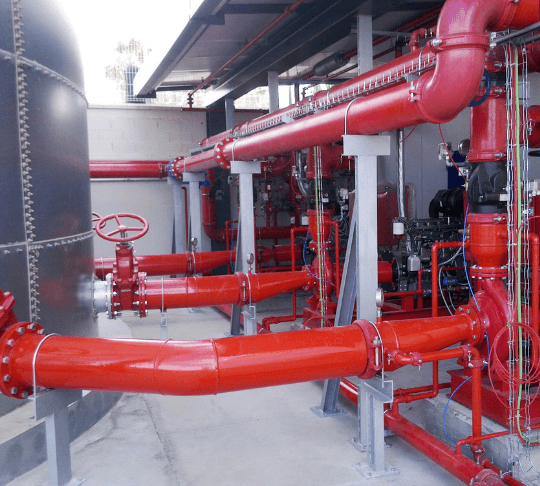Stationary Pumps for Fire Protection Systems
STATIONARY PUMPS FOR FIRE PROTECTION SYSTEMS
INTRODUCTION
Water is the best known, cheapest and most abundant extinguishing agent nature has to offer us, and for these reasons water-based extinguishing systems are the most commonly used fire protection systems in buildings and industries. It is used in manual or automatic applications, alone or with additives such as antifreeze, foam, etc. It is the extinguishing agent that does not need any transformation processes. The only conditions needed to use it efficiently are pressure and continuous flow with respect to the type of risk.
To ensure that the necessary pressure and flow are available at all times, a water supply system is needed.
This water supply is essential to operate the fire extinguishing systems . A risk could be protected by all the current systems of safety that if the fire supply system does not work, all the systems are not going to work. The water supply systems is to the instalation, giving the heart to the human body. If the water supply system fail (inadequate design, installation, maintenance, etc.) our system would be useless.
Thanks to our extensive knowledge based on more than 50 years’ experience here at PEFIPRESA we offer the highest level of success by taking into consideration the unique characteristics of each risk and apply the best technical and efficient solutions, whilst minimising the impact on the environment.

BASIC PRINCIPLES
The stationary pump for fire protection system is basically formed through a set of water sources, impulse systems and a general fire network designed to operate one or several specific protection systems, the water flow and pressure during the autonomy time required. At all times, the design must be in compliance with the applicable fire protection regulations.
In any extinction system, different factors must be taken into account to ensure the correct application of water in firefighting.
The water supply must be exclusive for the fire protection systems and they must come into operation automatically. Their activation must be guaranteed, and be in a continuous state of rest and until they are activated during the start-up of the installation, in maintenance tests, inspections and in case of fire. Given this, it is important that the system is unaffected by external factors such as frost, drought, flooding and in the case of electric motors, any power shortages. Solid materials must be clear to avoid the obstruction of the conductions.
Though it seems obvious, it is important to emphasise that the system must have a sufficient water supply in base of autonomy time required by the systems and ensure water travels through buried or overhead pipe networks and pressure losses are taken into consideration to reach the facilities, specific equipment of each risk (hydrants, BIES, sprinklers, water spray, foam, etc.) and taking into account the hydraulic demand of each one. At the same,in the conditions of simultaneity established by the applicable regulations in each case.
- Correct choice of pumps (flow and pressure).
- Correct choice of engine powers (electric motor and diesel engine).
- Motor pump frames with electric motor as well as diesel engine.
- Automatic start of pumps despite the circumstances and scenario.
- Manual stop control of pumps except jockey pump that can be automatic.
- Adequate installation of the equipment (convenient suction “on load” NPSH, suction and discharge diameter).
- Hydro pneumatic accumulator
- Apparatus for measuring flow and pressure (hand gauges, pressure gauges, pressure switches, flow meter etc.)
- Minimum flow safety valves.
- Appropiate pump room valves taking into account; type, location, quality, certifications, possibility of open-closed control, state transmissions, etc.
In any fire protection system, its reliability is imperative. PEFIPRESA has both human and technical resources and the experience of thousands of installations carried out in order to ensure optimum design, installation and maintenance for perfect operation in case of fire.



